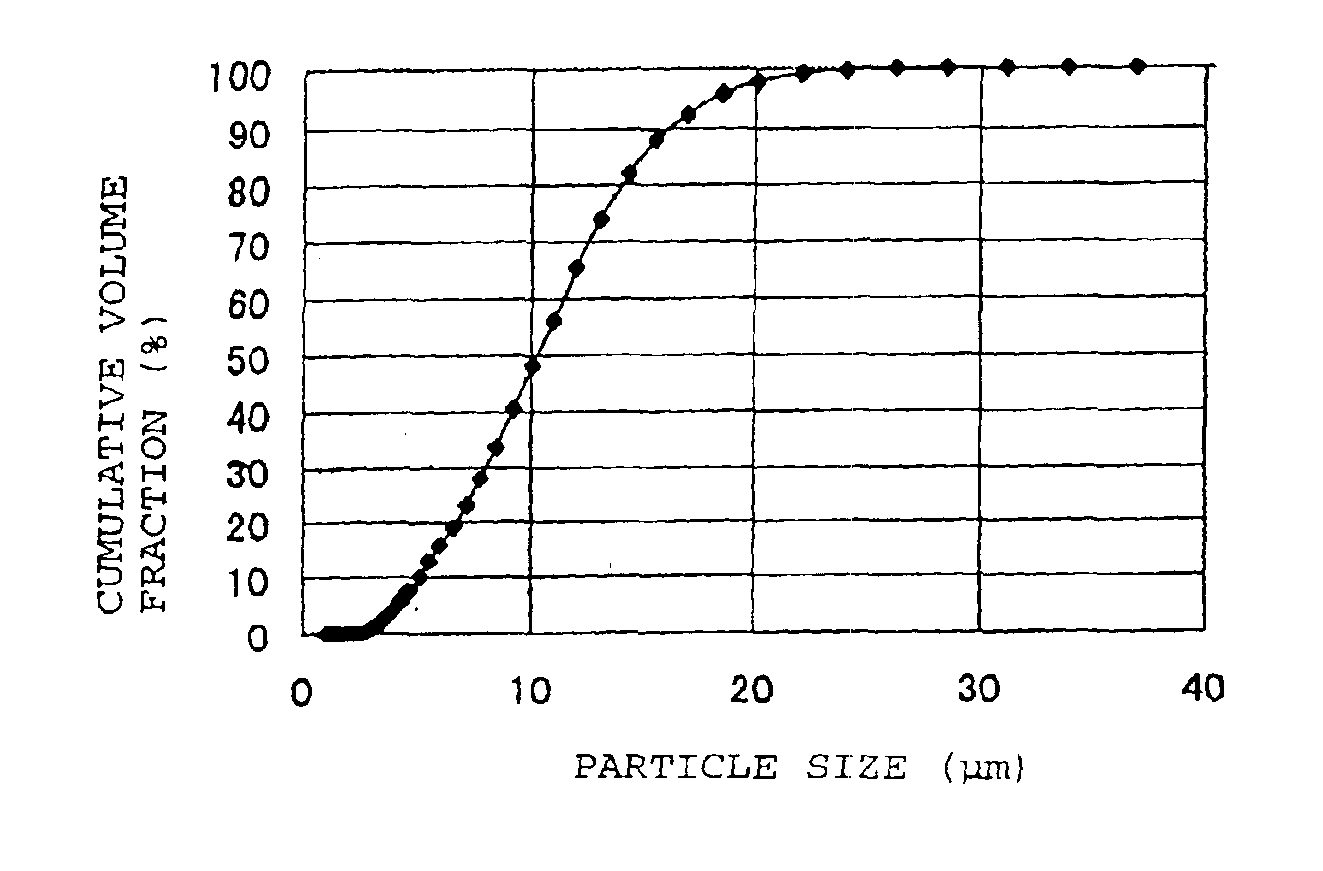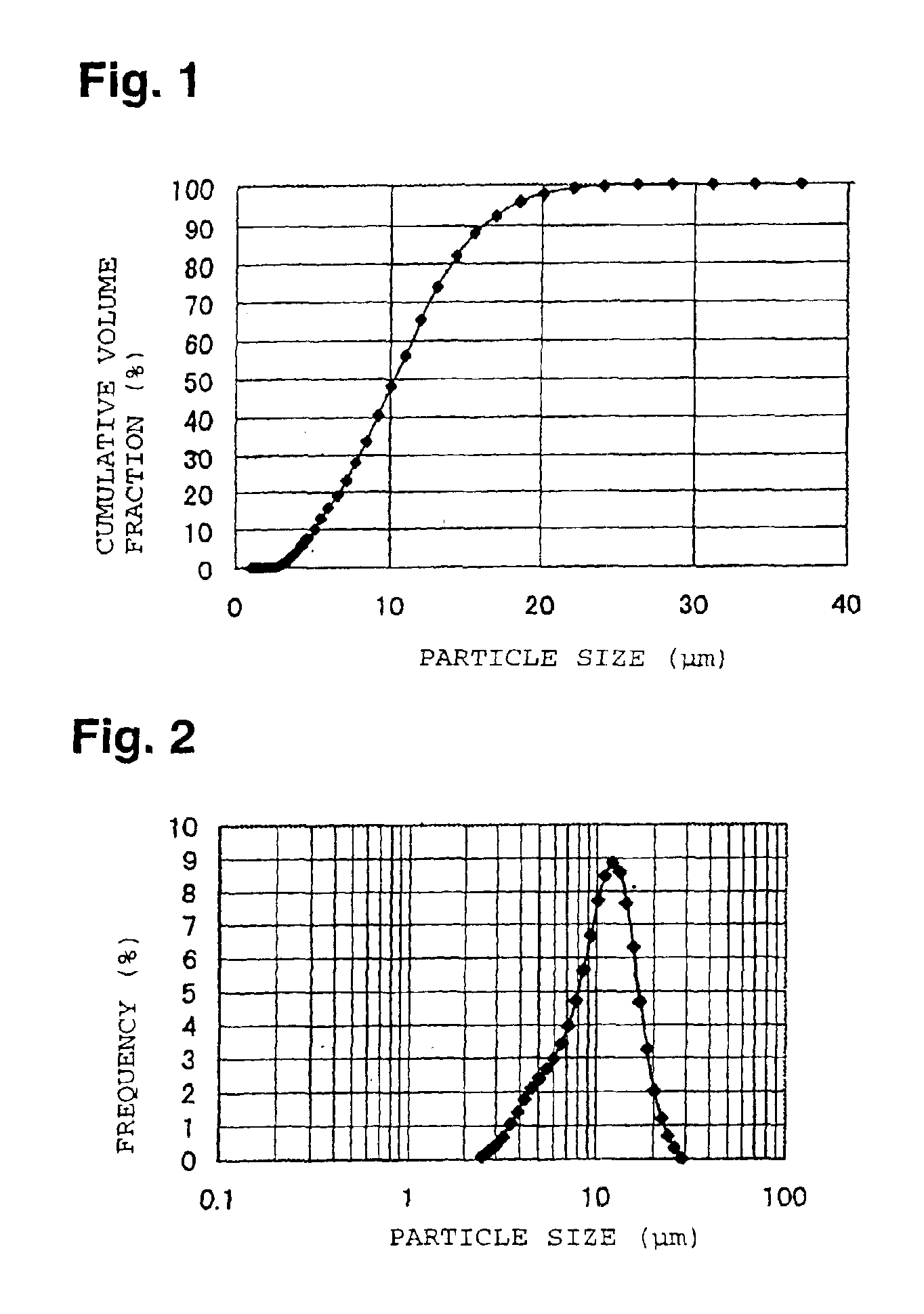Lithium-transition metal composite oxide
a technology of composite oxide and lithium-transition metal, which is applied in the direction of nickel compounds, alkali titanates, cell components, etc., can solve the problems of deterioration of cycle characteristics, large decrease of discharge capacity, and gradual decrease of discharge capacity of cells, etc., to achieve excellent uniform coating properties, large volume capacity density, and high safety
- Summary
- Abstract
- Description
- Claims
- Application Information
AI Technical Summary
Benefits of technology
Problems solved by technology
Method used
Image
Examples
example 1
[0057]A cobalt oxyhydroxide powder having a specific surface area of 65 m2 / g, a lithium carbonate powder having a specific surface area of 1.2 m2 / g, were mixed. The mixing ratio was such that the composition would be LiCoO2 after firing. These two types of powders were dry-blended and then fired at 930° C. for 12 hours in air. The fired material thus obtained was pulverized and classified so that its average particle size became about 10 μm to obtain LiCoO2 powder.
[0058]With respect to the LiCoO2 powder after fired, pulverized and classified, the X-ray diffraction spectrum was obtained by using an X-ray diffraction apparatus (RINT model 2100, manufactured by Rigaku Corporation). In this powder X-ray diffraction using CuKα ray, the half-width of the diffraction peak for (110) face in the vicinity of 2θ=66.5±1°, was 0.089°. Further, with respect to this LiCoO2 powder, the cumulative pore volume of pores having pore diameters of from 0.006 to 1 μm was measured by a mercury injection ty...
example 2
[0066]In the same manner as in Example 1, a cobalt oxyhydroxide powder having a specific surface area of 87 m2 / g, and a lithium carbonate powder having a specific surface area of 1.0 m2 / g, were mixed. The mixing ratio was such that the composition would be LiCoO2 after firing. These two types of powders were dry-blended and then fired at 900° C. for 12 hours in air in the same manner as in Example 1.
[0067]With respect to the powder pulverized and classified so that its average particle size became about 15 μm, the cumulative pore volume of pores having pore diameters of from 0.006 to 1 μm was measured by a mercury injection type porosimeter, and as a result, the pore volume was at most 0.01 cc / g.
[0068]With respect to the powder after pulverized and classified, the particle size distribution was measured in the same manner as in Example 1, and as a result, the particle size D5 was 7.4 μm, the particle size D95 was 24.1 μm, the volume fraction of particles having particle sizes of les...
example 3
[0071]In the same manner as in Example 1, a cobalt oxyhydroxide powder having a specific surface area of 65 m2 / g, a lithium carbonate powder having a specific surface area of 1.2 m2 / g, and an anatase type titanium dioxide powder having a specific surface area of 9 m2 / g were mixed. The mixing ratio was such that the composition would be LiCo0.998Ti0.002O2 after firing. These three types of powders were dry-blended and then fired at 900° C. for 12 hours in air in the same manner as in Example 1.
[0072]With respect to the powder pulverized and classified so that its average particle size became about 15 μm, the cumulative pore volume of pores having pore diameters of from 0.006 to 1 μm was measured by a mercury injection type porosimeter, and as a result, the pore volume was at most 0.01 cc / g.
[0073]With respect to the powder after pulverized and classified, the particle size distribution was measured in the same manner as in Example 1, and as a result, the particle size D5 was 5.2 μm, t...
PUM
| Property | Measurement | Unit |
|---|---|---|
| particle size | aaaaa | aaaaa |
| cumulative volume fraction | aaaaa | aaaaa |
| cumulative volume fraction | aaaaa | aaaaa |
Abstract
Description
Claims
Application Information
 Login to View More
Login to View More - R&D
- Intellectual Property
- Life Sciences
- Materials
- Tech Scout
- Unparalleled Data Quality
- Higher Quality Content
- 60% Fewer Hallucinations
Browse by: Latest US Patents, China's latest patents, Technical Efficacy Thesaurus, Application Domain, Technology Topic, Popular Technical Reports.
© 2025 PatSnap. All rights reserved.Legal|Privacy policy|Modern Slavery Act Transparency Statement|Sitemap|About US| Contact US: help@patsnap.com



